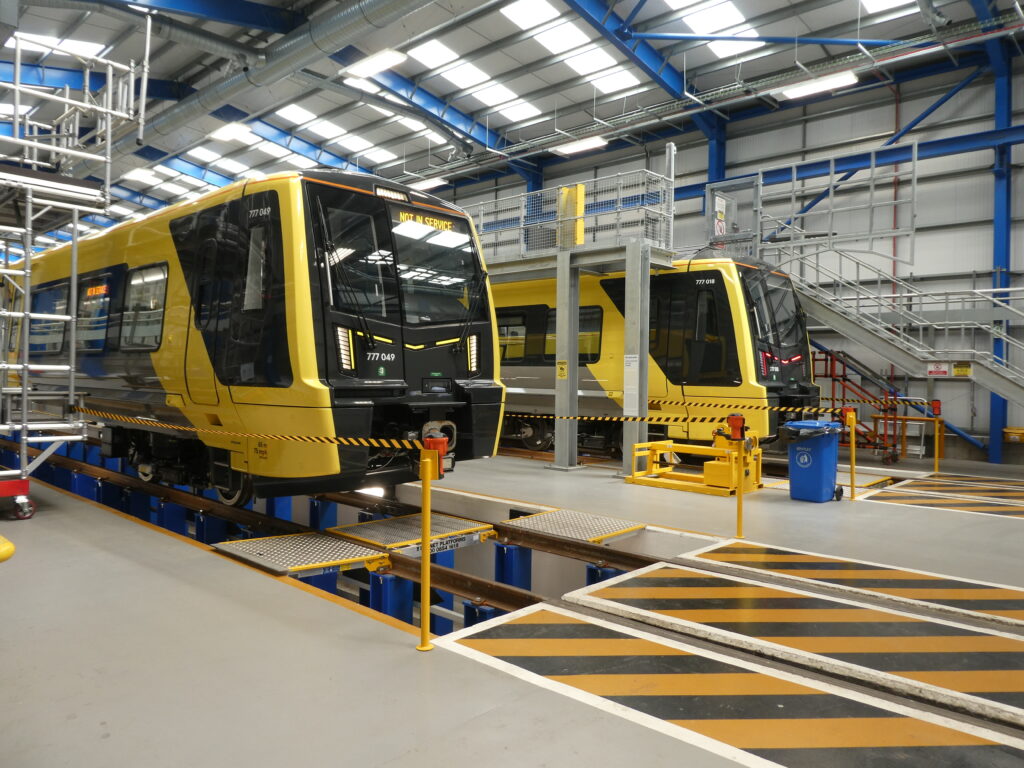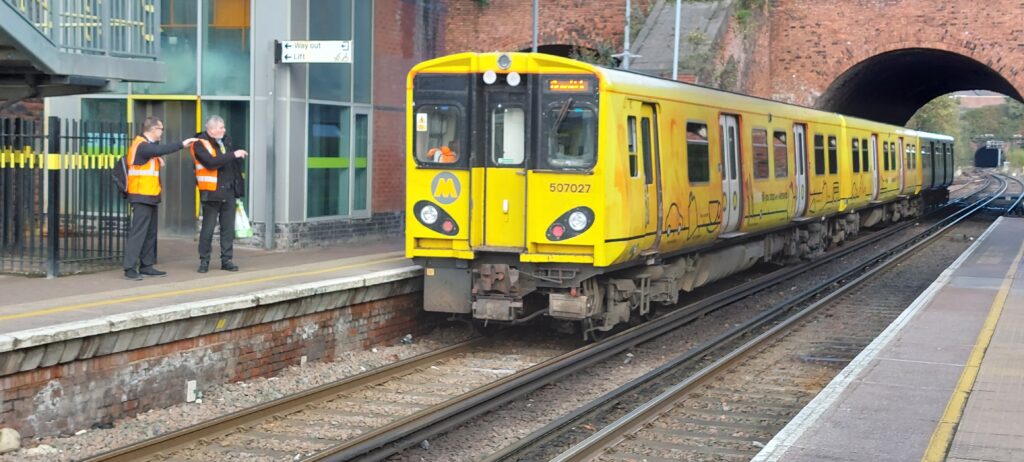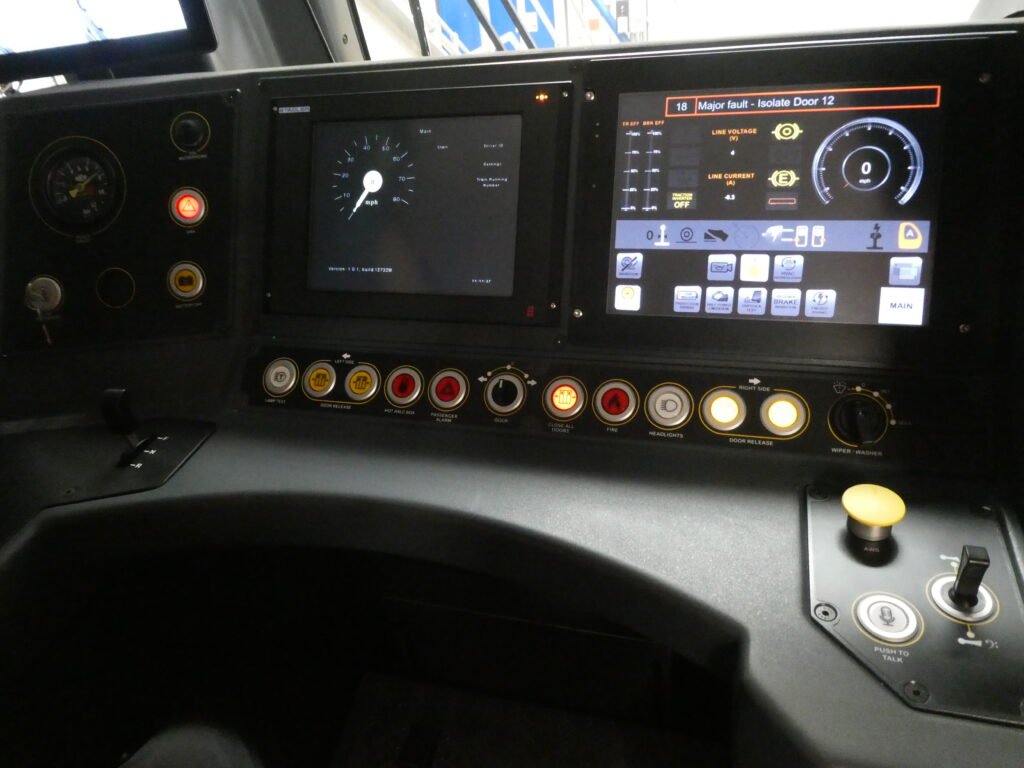In Rail Engineer 184 (May/June 2020), Paul Darlington described the upgrade of the Merseyside rail network in and around Liverpool, which involved new trains, upgraded infrastructure, power supplies and depots, together with a network wide train-infrastructure Wi-Fi system. To recap, MerseyRail is the largest third-rail electrified network outside London and the South East, has extensive underground running and is largely self-contained. Pre-Covid, the network carried 110,000 passengers on weekdays and a total of 34 million passengers per year along its 75 miles of route with 68 stations.
Six stations and 6.5 miles of route are underground. It is also unusual that, since 2002, the Liverpool Region Combined authority, through its Merseytravel arm, is the franchising authority for the network. It is currently operating the oldest fleet of any main line operator in the country but is on the cusp of a transformation. During a visit to Kirkdale depot in November 2022, David Powell, Merseytravel’s Project Director, briefed Rail Engineer about the Class 777 trains and the various system changes to enable their operation prior to the first train entering service which took place on 23 January 2023.
Before describing the trains, it’s worth remembering the benefits that were identified at the start of the programme in 2012:
- Improved safety, especially at the platform train interface having regard to the James Street fatality in 2011
- 10% journey time reduction
- 50% higher passenger capacity to meet rising demand
- Improved passenger facilities
- Future-proofed to operate beyond third-rail infrastructure
- The most accessible heavy rail network in the UK
- More reliable than Class 507/8
- Reduced operating and maintenance costs
- Reduced carbon footprint
Liverpool was in a position to fund the new trains for itself without recourse to a ROSCO. This allowed Liverpool to specify a train solely to meet its own needs without needing to think about residual value issues. The resulting finance model uses the council’s own reserves plus loans from the Public Works Loan Board and the European Investment Bank (one of the last loans to UK following Brexit).
Bespoke solution
Following competitive tendering in 2016, Stadler was selected to design and manufacture the trains and it was also decided to contract Stadler to maintain the trains – Stadler’s first maintenance contract in the UK. One of the benefits of choosing Stadler is that it specialises in bespoke solutions and Liverpool’s is a completely new design. Initially 52 x 4-car, 65-metre-long units were procured with an option for up to another 60. Since then, one additional train has been ordered. The rolling stock design was completed in 20 months following extensive interaction with passengers to determine key interior design features. David Powell described them as “Metro style units designed to mainline standards”. Bodyshells are made in Hungary, bogies in Spain, with final assembly in Switzerland and Poland.

Dynamic testing was carried out at the Siemens facility in Wildenrath, Germany. The first unit was delivered to the UK through the channel tunnel in January 2020. Not all the trains have yet been delivered to Liverpool which will be explained later in the article.
David said that right from the beginning and throughout the design process, customers were invited to express their desires for the new trains in work carried out by the research arm of Transport Focus. One key passenger requirement was for level access from platform to train in order to allow people with wheelchairs, buggies, and other mobility impairments to board and alight easily. This led to an early design decision to lower the floor from the usual 1100mm (approximately) to 960mm and use extending panels to bridge the gap between train and platform. These have ultrasonic sensors fitted which stop the extending panels approximately 35mm away from the platform edge. This and other features meant that a number of infrastructure changes were necessary which are covered later.
Features
The train’s outline specification can be seen at the end of the article, but notable features include open wide gangways throughout the unit, air conditioning, 240V 13A & USB sockets at every pair of seats, and line maps displayed on LCD screens. Research indicated that customers like to know that the security CCTV is working, so images from the saloons are also displayed on the LCD screens. On each unit, there are two storage areas for three bicycles.
The cab design is unique. The nature of the tunnels is such that there needs to be a means to evacuate passengers from the front of the train. But there was also a desire to improve sightlines for the driver which meant larger windscreens compared with the old trains. So, unlike the old Class 507/8 units, rather than in the centre of the cab front, detrainment is via a sliding plug door fitted on the right-hand side. This is accompanied with an angled ladder which runs from this doorway to the middle of the track (a straight ladder might have ‘landed’ right above the conductor rail). In the event that a train-to-train detrainment is required, clearly the detrainment doors will be on opposite sides of the coupled units, and for this a series of platforms and barriers are deployed to provide a safe gangway.
Each passenger door is monitored by its own external CCTV camera and two monitors, each displaying views from four cameras, provided in the cabs. It is planned to operate the trains with the driver controlling the doors and a train manager will look after the customers and perform a platform check at stations.

For maintenance, Kirkdale depot has been extensively modernised. With pit roads and high-level platforms to access roof mounted equipment (antennae, air conditioning packs, dynamic brake resistors, etc). In passing, the end cars have panelling on the roof to smooth the flow of side winds over the body. Modelling had shown that there was a risk of overturning in the presence of side winds specified by standards. This was not a risk on the shorter intermediate vehicles. David said that he hopes, in time, to justify their removal as they are an impediment to maintenance. The depot has three-phase shore supplies to power the units’ auxiliaries, but movement in and out of the sheds is powered by the train’s limited movement batteries.
BEMU
Merseytravel has ambitions to extend the MerseyRail network, and, with ORR ‘presuming against extensions of third-rail systems’, provision was made on the trains for 25kV supply or batteries with space under each end car. At Rail Live 2021, Stadler demonstrated a prototype battery-powered Class 777 unit with batteries weighing 2.5 tonnes. This was used to explore practical range on the Liverpool network, resulting in Merseytravel varying the order to increase the order to 53 trains, seven of which will have three tonnes of batteries on each end car, together with an additional power converter (increasing the tare mass by approximately 6%). The batteries will be Lithium Titanate Oxide type with a total capacity of 320kWh. These give a good combination of energy and power density and have an inherent resistance to thermal runaway. The initial off-third-rail section will be a one-mile extension from Kirkby to a new station at Headbolt Lane, but David says that there is an ambition to extend to other locations such as Wrexham. The first production Class 777 BEMU delivered an encouraging 135km range which shows what is possible.
Infrastructure
Having resolved to have lower train floors, clearly the platforms needed to be compatible. The aim was to deliver platforms at or close to the standard 915mm height and 730mm offset. David reported that 92 platforms at 56 stations had to be modified for height, offset, or both. This programme was managed by Network Rail, and David praised the way the work was delivered on time. In general, the work was carried out in line blockades with a number of platforms being tackled simultaneously. Other changes, including moving signals at the ends of some platforms, are being undertaken. To satisfy the ambition to run 8-car, 130-metre trains, some platforms and the turnback siding in the underground section at Liverpool Central need to be extended.
Power supply
At 2100kW peak power output at the wheels, the new trains demand about three times the power of the existing train. The power supply was upgraded to address existing volt drop issue and to raise the maximum current draw from 4000 A to 5400 A. This was achieved by providing three new bulk supply points (from the regional electricity company to the railway), eight new substations and extensive cable upgrades.
Wireless connectivity
The last element of the upgrade is the wireless connectivity system. David said that the business case for upgraded comms was based on: obtaining data from the trains to enable predictive maintenance; reducing workload on the drivers; ability to access both live and recorded CCTV both in the operations and British Transport Police control rooms; to update passenger information in real time; and to send emergency alerts to the Sandhills control room (where Network Rail, MerseyRail, and Stadler personnel are co-located). It was these features that gave a positive business case but, as a by-product, customers get access to on-train Wi-Fi too. The technology is Wi-Fi throughout, rather than the more usual on-train Wi-Fi connected to the infrastructure via 4/5g mobile modems. Panasonic is providing the system and David mentioned the 120km of trackside cables that have had to be installed.

Introduction into service
As described above, fleet introduction, initially on the Kirkby line started in mid-January 2023. From there a complex cascade starts. With 59 old trains, 53 new ones, and only 70 unit stabling/siding spaces, David’s extended project team has prepared a detailed plan to manage hand back of the old fleet to Angel Trains (Class 507/8 ROSCO) whilst training all the staff who will interact with the new trains, bringing more and more trains onto the network and ensuring that fault free running has been completed, whilst managing the inevitable modifications that all new trains require, especially after being exposed to passenger operation for the first time.
Finally, David paid tribute to the teams who have worked on this programme. Vital to the programme has been cross organisation teamwork including: willingness to share information, recognition of each other’s perspectives and, above all, compromise.
With thanks to David Powell, his assistant Jane Brimage, and to Stadler’s Alex Maher for their assistance with this article.
Class 777 features
- Four-car articulated unit.
- Bogie arrangement: Trailer – motor – motor – motor – trailer.
- Lightweight carriage body made of extruded aluminium profiles.
- Newly developed motor trailer bogies with internal bogie frames, pneumatic suspension and wheel tread friction brakes; motor bogies under articulated joints.
- Modern vehicle control system.
- Automatic front coupler for multiple operation.
- Plug sliding doors and sliding steps for level entrance.
- AWS/TPWS/tripcock train protection and Automatic Selective Door Open system.
- Prepared for later retrofit of ETCS and 25 kV power supply equipment.
- Train batteries allowing depot movements independently of power supply; units are designed to allow later installation of much larger batteries, implemented on the 7 BEMU units ordered.
Comfort
- Bright, passenger-friendly interior with an iconic design
- Six entrance doorways on each side for rapid passenger flow
- Level access at all entrances
- Spacious multifunction areas and wheelchair spaces
- Modern passenger information system and CCTV
- Powerful HVAC system
Personnel
- Spacious cab with excellent driver sight lines
- Ergonomically designed driver’s desk
- Automated cab side doors for comfortable access
- Reliability/Availability/Maintainability/Safety
- Three IGBT three-phase drive systems; one per pair of motors (ABB)
- Force cooled traction motors (TSA)
- Remote vehicle diagnostics to support condition-based maintenance
- Automated front bridging system for movement between units for evacuation
Supply voltage: 750 VDC
Number of units: 53 with options for another 59
Seats (one class only): 182 (Class 507: 192)
Tip-up seats: 8
Standing capacity (4 pers./m2): 302
Floor height: 960mm (Class 507: 1100mm)
Doorway width: 1300mm
Unit length: 64980mm
Vehicle width: 2820mm
Vehicle height: 3828mm
Bogie wheelbase: 2400mm
Wheel diameter, new: 760mm (similar size to Underground tube stock)
Power output at wheel: 1500kW [Continuous] (Class 507: 650kW)
Power output at wheel: 2100kW Maximum
Starting tractive effort: 162kN (up to 46km/h)
Starting acceleration: 1.1m/s²
Maximum speed: 120km/h
Tare mass: 100 t (Class 507: 104.5 t)

